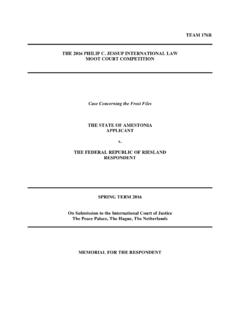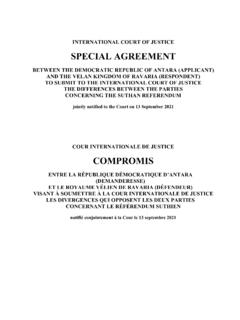Transcription of Protocol Additional to the Geneva Conventions of 12 August ...
1 The following is mirrored from its source at: Protocol Additional to the Geneva Conventions of 12 August 1949, and relating tothe Protection of Victims of International Armed Conflicts ( Protocol 1) Adopted on 8 June 1977 by the Diplomatic Conference on the Reaffirmation and Development of International Humanitarian Law applicable in Armed Conflicts entry into force 7 December 1979, in accordance with Article 95 Preamble The High Contracting Parties, Proclaiming their earnest wish to see peace prevail among peoples, Recalling that every State has the duty, in conformity with the Charter of the United Nations, to refrain in itsinternational relations from the threat or use of force against the sovereignty, territorial integrity or politicalindependence of any State, or in any other manner inconsistent with the purposes of the United Nations.
2 Believing it necessary nevertheless to reaffirm and develop the provisions protecting the victims of armedconflicts and to supplement measures intended to reinforce their application, Expressing their conviction that nothing in this Protocol or in the Geneva Conventions of 12 August 1949 canbe construed as legitimizing or authorizing any act of aggression or any other use of force inconsistent with theCharter of the United Nations, Reaffirming further that the provisions of the Geneva Conventions of 12 August 1949 and of this Protocol mustbe fully applied in all circumstances to all persons who are protected by those instruments, without any adversedistinction based on the nature or origin of the armed conflict or on the causes espoused by or attributed to theParties to the conflicts, Have agreed on the following: PART I GENERAL PROVISIONS Article principles and scope of application 1.
3 The High Contracting Parties undertake to respect and to ensure respect for this Protocol in allcircumstances. 2. In cases not covered by this Protocol or by other international agreements, civilians and combatants remainunder the protection and authority of the principles of international law derived from established custom, fromthe principles of humanity and from the dictates of public conscience. 3. This Protocol , which supplements the Geneva Conventions of 12 August 1949 for the protection of warvictims, shall apply in the situations referred to in Article 2 common to those Conventions . 4. The situations referred to in the preceding paragraph include armed conflicts in which peoples are fightingagainst colonial domination and alien occupation and against racist regimes in the exercise of their right ofself-determination, as enshrined in the Charter of the United Nations and the Declaration on Principles ofInternational Law concerning Friendly Relations and Co-operation among States in accordance with the Charterof the United Nations.
4 Article For the purposes of this Protocol : (a) "First Convention", "Second Convention", "Third Convention" and "Fourth Convention" mean,respectively, the Geneva Convention for the Amelioration of the Condition of the Wounded and Sick in ArmedForces in the Field of 12 August 1949; the Geneva Convention for the Amelioration of the Condition ofWounded, Sick and Shipwrecked Members of Armed Forces at Sea of 12 August 1949; the Geneva Conventionrelative to the Treatment of Prisoners of War of 12 August 1949; the Geneva Convention relative to theProtection of Civilian Persons in Time of War of 12 August 1949; "the Conventions " means the four GenevaConventions of 12 August 1949; for the protection of war victims; (b) Rules of international law applicable in armed conflict" means the rules applicable in armed conflict setforth in international agreements to which the Parties to the conflict are Parties and the generally recognizedprinciples and rules of international law which are applicable to armed conflict; (c) Protecting Power" means a neutral or other State not a Party to the conflict which has been designated by aParty to the conflict and accepted by the adverse Party and has agreed to carry out the functions assigned to aProtecting Power under the Conventions and this Protocol .
5 (d) Substitute" means an organization acting in place of a Protecting Power in accordance with Article 5. Article and end of application Without prejudice to the provisions which are applicable at all times: (a) The Conventions and this Protocol shall apply from the beginning of any situation referred to in Article 1 ofthis Protocol ; (b) The application of the Conventions and of this Protocol shall cease, in the territory of Parties to the conflict,on the general close of military operations and, in the case of occupied territories, on the termination of theoccupation, except, in either circumstance, for those persons whose final release, repatriation orre-establishment takes place thereafter. These persons shall continue to benefit from the relevant provisions ofthe Conventions and of this Protocol until their final release, repatriation or re-establishment.
6 Article status of the Parties to the conflict The application of the Conventions and of this Protocol , as well as the conclusion of the agreements providedfor therein, shall not affect the legal status of the Parties to the conflict. Neither the occupation of a territory northe application of the Conventions and this Protocol shall affect the legal status of the territory in question. Article of Protecting Powers and of their substitute 1. It is the duty of the Parties to a conflict from the beginning of that conflict to secure the supervision andimplementation of the Conventions and of this Protocol by the application of the system of Protecting Powers,including inter alia the designation and acceptance of those Powers, in accordance with the followingparagraphs.
7 Protecting Powers shall have the duty of safeguarding the interests of the Parties to the conflict. 2. From the beginning of a situation referred to in Article each Party to the conflict shall without delaydesignate a Protecting Power for the purpose of applying the Conventions and this Protocol and shall, likewisewithout delay and for the same purpose, permit the activities of a Protecting Power which has been accepted byit as such after designation by the adverse Party. 3. If a Protecting Power has not been designated or accepted from the beginning of a situation referred to inArticle 1, the International Committee of the Red Cross, without prejudice to the right of any other impartial humanitarian organization to do likewise,shall offer its good offices to the Parties to the conflict with a view to the designation without delay of aProtecting Power to which the Parties to the conflict consent.
8 For that purpose it may, inter alia, ask each Partyto provide it with a list of at least five States which that Party considers acceptable to act as Protecting Poweron its behalf in relation to an adverse Party, and ask each adverse Party to provide a list of at least five Stateswhich it would accept as the Protecting Power of the first Party; these lists shall be communicated to theCommittee within two weeks after the receipt of the request; it shall compare them and seek the agreement ofany proposed State named on both lists. 4. If, despite the foregoing, there is no Protecting Power, the Parties to the conflict shall accept without delay anoffer which may be made by the International Committee of the Red Cross or by any other organization whichoffers all guarantees of impartiality and efficacy, after due consultations with the said Parties and taking intoaccount the result of these consultations, to act as a substitute.
9 The functioning of such a substitute is subject tothe consent of the Parties to the conflict; every effort shall be made by the Parties to the conflict to facilitate theoperations of the substitute in the performance of its tasks under the Conventions and this Protocol . 5. In accordance with Article 4, the designation and acceptance of Protecting Powers for the purpose ofapplying the Conventions and this Protocol shall not affect the legal status of the Parties to the conflict or ofany territory, including occupied territory. 6. The maintenance of diplomatic relations between Parties to the conflict or the entrusting of the protection ofa Party s interests and those of its nationals to a third State in accordance with the rules of international lawrelating to diplomatic relations is no obstacle to the designation of Protecting Powers for the purpose ofapplying the Conventions and this Protocol .
10 7. Any subsequent mention in this Protocol of a Protecting Power includes also a substitute. Article persons 1. The High Contracting Parties shall, also in peacetime, endeavour, with the assistance of the national RedCross (Red crescent , Red Lion and Sun) Societies, to train qualified personnel to facilitate the application ofthe Conventions and of this Protocol , and in particular the activities of the Protecting Powers. 2. The recruitment and training of such personnel are within domestic jurisdiction. 3. The International Committee of the Red Cross shall hold at the disposal of the High Contracting Parties thelists of persons so trained which the High Contracting Parties may have established and may have transmitted to it for that purpose.









